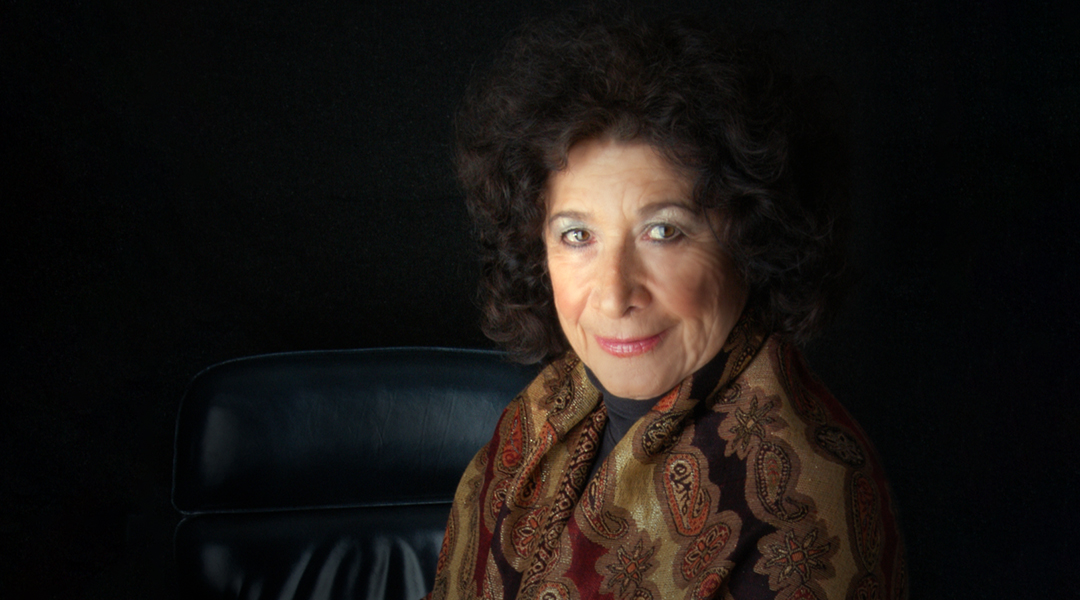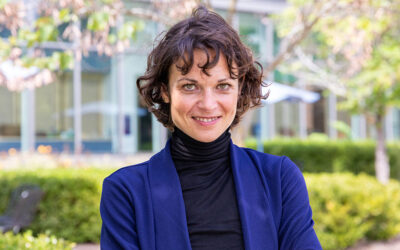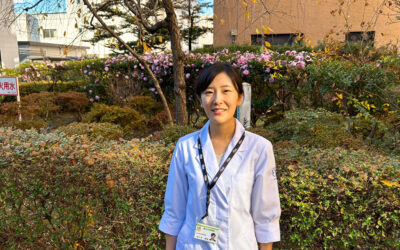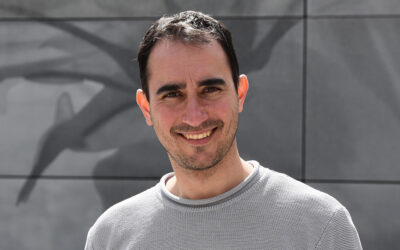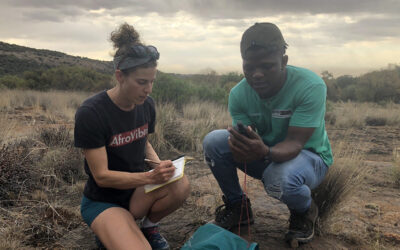Born and raised in Israel, Zafra Lerman discovered her lifelong passion for the sciences early on. An outstanding talent at a very young age, she eventually became a professor of chemistry, but has taken a unique approach to getting her arts-oriented students excited about the sciences. However, her impact goes far beyond research and teaching. She believes that a shared passion can help promote peace in unstable regions around the world.
For Lerman, science diplomacy is vital to unify people with political, cultural, and religious differences. As president of the Malta Conferences Foundation, she provides a platform where scientists from hostile countries can peacefully discuss their research and form collaborations greater than the scope of the conference. Lerman’s outstanding humanitarian work has been awarded countless times and even put her on the shortlist for the Nobel Peace Prize.
We had the great honor of talking to Lerman about her unprecedented career in which she unifies people to help solve conflicts with science, resourcefulness, and understanding.
You have taught science at all levels. When did you get involved in teaching?
After doing research at Cornell and Northwestern University and then going to Switzerland, I decided I wanted to make a change in the realm of teaching. I was getting very tired of hearing about under-representation in science. I told myself that I would show that underrepresented groups can be as good as anybody if you teach science the right way.
Columbia College in Chicago was a wonderful school back then, and the president at the time was a visionary leader. It was mainly an art school, but because it was an accredited university, he needed more of the sciences represented.
He sent a letter around to people involved in human rights and nuclear disarmament, and Frank Long, my postdoc supervisor, got one of these letters. He said he had the perfect person and he recommended me, and so I came.
Did you have mentors who supported you along the way?
The person that influenced my life the most was my postdoc professor, Frank Long. I did my Ph.D. at the Weizmann Institute of Science and then came to Cornell University in Ithaca to their chemistry department for my postdoc. He was not only a very good chemist, but he was also on a scientific advisory committee to [US] presidents since Eisenhower and Kennedy — he was involved in negotiating the Nuclear Test Ban Treaty with the Soviets.
I remember to this day, we were discussing the entropy of activation when suddenly a phone call came and the secretary said, “Jerry Wisner (the president of MIT and the person who helped develop radar in the Second World War) is on the phone.” I was listening to this conversation and was fascinated because I had just come to the United States and I felt I was sitting on top of the world with such important people.
I have to give Frank Long credit for a career that did a lot of good for people, and I got involved with him in issues of nuclear disarmament and human rights.
During your career, you have developed innovative methods to teach science by combining them with the arts. Why did you go this non-traditional teaching route?
[When I joined Columbia College in Chicago], I had to build science classes for non-science majors from scratch, and I remember the first class I wanted to offer was called “Chemistry in Daily Life”.
Nobody signed up for my class initially because the students did not think chemistry was useful, so I had to find a way to attract them. I took a group of 20 students to a bar across the street from the university and I told them to order what they wanted. I asked them what they were drinking, and they would list off the ingredients and then say alcohol. So, I asked them, “What is alcohol?” They said it was something that made them feel good. I said again “But what is alcohol?” I then took a napkin, and I drew the molecular structure of ethanol and I told them this is what they were drinking. They all started drawing it on their napkins and the whole bar was listening to my lecture.
Then I ordered a salad with oil and vinegar, and I asked them about vinegar, and I started drawing acetic acid and I told them this could be used for nail polish remover. The students were concerned they were drinking nail polish remover and I told them it was fine because it needed a catalyst, so they asked me about catalysts. I explained to them what a catalyst is and I said this semester is 15 weeks long and they already had the first class, so there were only 14 weeks to go if they registered.
I learned from that experience that you must teach something relevant to students’ lives.
Another time, I was teaching a certain chemical reaction and the students did not understand, so one of the students, who was a dance student, got up and assigned different chemicals to different students and they started dancing around each other like the chemicals would and they began to understand the reaction.
So basically, I got to this way of teaching because my teachers where my students. They showed me how they understood and how they learned. In the beginning, [some] scientists were angry with me, saying I was diluting the science, but it worked, and today, many educators are discovering again this way of teaching.
I then suggested to the heads of the chemistry departments at Princeton and Indiana Universities to write a proposal with me to the National Science Foundation (NSF) to develop a class for non-science majors using my teaching methods and adopt it in our three institutions. They agreed and the NSF funded the proposal and even called it their “flagship project”.
To prove that my underprivileged students could compete with the students at Princeton, I would take my class from Chicago to Princeton every year for a joint symposium. They showed the scientific material in creative ways, like dance and theater. In one example, they wanted to show ionic bonds, so they followed Shakespeare’s Romeo and Juliet and they wrote a love story between sodium and chlorine where they kissed and transferred the electron to form an ionic bond for the table salt. With Shakespeare, we need a tragedy, so then the water came and broke up the marriage. There was also the “bond father” with a chemical bond like the Godfather and the depletion of the ozone layer using Star Wars. The media came to the first meeting at Princeton and called it “the meeting of two cultures”.
How challenging is it to bring the arts and sciences together?
I always loved the arts, so it was fascinating for me to see this connection. At the end of every course, the students had to produce a final project using their creative majors. I remember when Al Gore did his documentary on climate change, my students said they made a much better video for their final project, and nobody gave them an Oscar, or a Nobel Peace Prize like Al Gore received.
The NSF gave me a lot of money to go into the inner cities and help minority students and work with their teachers to adopt this way of teaching. We also worked with homeless kids, where at night they came to a dance studio where the parents of one of my dance students would run lessons, and we taught them chemistry through dance. Many of them went on to college and to continue their Ph.D. in biochemistry as a result of this school. CNN did a program on them, which was seen all over the world.
You are an advocate for using science as a platform to promote peace and further human rights. Was there a specific event that inspired this work?
My human rights work started early with human rights abuses of scientists in the Soviet Union. They were called “Refuseniks”. There were excellent scientists who wanted to leave the Soviet Union and were not allowed and then fired from their jobs, arrested, and sent to labor camps. They were in a terrible situation but there were other groups working on their behalf, like The Committee of Concerned Scientists, of which I am the vice chair of the board. They started when famous dissidents, like Sakharov, Orlov, and Sharansky (SOS), were arrested or exiled for speaking up for human rights. We were sending many letters to the leaders of the Soviet Union, expressing our concern for the wellbeing of dissidents. I travelled several times to the Soviet Union to help them.
I met Andrei Sakharov in the 1980s in the United States when he received the Peace Prize from the Albert Einstein Peace Prize Foundation of which I was on the executive committee. I met with him using a translator and he recommended I take a crash course in Russian before I return to the Soviet Union. I followed his advice. I usually went with a group of chemists in an organized tour where we interacted with the chemistry departments in the universities and gave lectures and symposia.
At night, after midnight, I would leave and go to dark alleys where a “Refusenik” would wait for me in a certain place that I could arrange and then we went and collected more.By two o’clock in the morning, we had maybe 50 of them in a dark attic in some apartment. I delivered a seminar and I brought scientific materials, which was not allowed. I took their CVs back to the United States to work on their behalf.
All these activities were illegal in the Soviet Union. If I had been caught, I would probably have ended up in some prison in the Soviet Union. As I did these activities, I would usually find a woman in our group who looked brave and I told her that, if I was not there for breakfast the next morning, to call the American embassy.
Can you share with us some examples of human rights violations you focused on?
Following the Tiananmen Square uprising, I went many times to China to work on human rights. One of the people on whose behalf I worked was the father of the pro-democracy movement, Fang Lizhi, an astrophysicist. He was hiding in the American embassy for a whole year. When he was allowed to leave, he came to Chicago and was my guest. From my office, he gave the first speech in Chinese to the people in China through “Voice of America” [an international radio broadcast].
I also worked in Cuba when I brought a delegation of chemists to participate in a chemistry conference and deliver lectures. Since the 1990s, I led seven delegations to Cuba. We needed a special license because the United States has an embargo against Cuba. During these trips, I was lecturing in the conference, and after that, working on the human rights of scientists. The Cuban Chemical Society made me an honorary member in a ceremony held in Havana.
In China, while I was delivering a plenary lecture, I dedicated the lecture to the prisoners who were still in jail since the Tiananmen Square incident. The Americans in the audience were very angry with me because they said I would cause all of them to be arrested. Interestingly, I was interviewed after that lecture on national Chinese television, and I also had the privilege to be interviewed on Cuban national television.
On September 11th, 2001, when the twin towers in New York were attacked, I was sitting in Israel along the Mediterranean in a beautiful café. I was on the phone with somebody from the defense ministry. They told me over the phone that the first twin tower was attacked and while we continued the conversation, the second tower was attacked.
My son was working in New York, but any contact was immediately impossible, and I was very worried. After this incident, in a meeting of the Committee on Scientific Freedom and Human Rights of the American Chemical Society, I suggested it was time to turn our attention to the Middle East. This is when the Malta Conferences were born.
Can you tell us about the “Malta Conferences”? What is your role there, what does the organization aim to achieve and how did you first get involved?
In 2002, we had the National American Chemical Society (ACS) meeting in Orlando, Florida, and I managed to bring two scientists from Cuba that I met because I organized a symposium on the scientific relationship between the United States and Cuba.
We were told to bring big ideas, outside of the box, to the International Activities Committee of ACS. When my turn came, I suggested we organize a conference for scientists from all the 15 Middle East countries and bring them all together under the same roof for five days with six Nobel laureates to develop friendships and collaboration that can overcome the chasms of distrust and intolerance.
By doing that, we could move a few centimeters towards peace in the Middle East. Suddenly there was complete silence. Then finally, they started asking questions like, “How would I get six Nobel laureates to meet in this kind of conference?” I said I would make six phone calls and I would stay on the phone until I got a “yes”. I was asked how I would get participants and I said I have contracts in all these countries. I know scientists who will help me find people and we will bring them together.
There was push back when I said there could be no one accompanying the participants [spouses, guests, etc.]. In chemistry, when you dilute the solution, the reaction becomes much slower, and we needed a fast reaction — we could not dilute it. Everybody would stay in the same hotel, eat all their meals together, attend workshops, lectures, and social events together, and by the end, it would be like a family.
Malta was chosen because this was taking place at the height of the Intifada and the terrible conflict between the Palestinians and the Israelis. I thought an island was safer than a mainland country, and in 2003, there were not many countries where you could fly directly to Malta. It took a very long time and you had to change flights. We were so nervous at the first conference how this would work.
How can scientific exchange and collaboration promote peace in politically unstable regions?
The Subcommittee on Scientific Freedom and Human Rights, which I chaired for 26 years, was dealing with helping Palestinian scientists who had trouble in getting to their conferences because of checkpoints and paperwork. We had 10 Palestinians who were invited to Malta. I was very worried that they would have problems arriving.
Luckily, a month before the conference, as a member of the Presidential Circle of the Chicago Council on Global Affairs, I was attending a lecture where the speaker was the Deputy Prime Minister of Israel at the time, Ehud Olmert. After the lecture, I told him that for many years I hated his right-wing politics when he was the mayor of Jerusalem, but that the lecture he gave was the best talk I ever heard, and then we started talking some more. I told him I had one request and I gave him a list of 10 Palestinians who must come to Malta with a smile on their faces and with no problems. He promised me this would happen.
The conference started on a Sunday evening with a reception and dinner, and the Palestinians were not there. I was going crazy and then suddenly I saw them, and I felt so relieved. Then each of them said they got a call from Olmert’s office telling them they will get help to attend the Malta Conference with no obstacles, but that they must come with a smile on their face. They were so happy with how they were treated and that they could come. I am always thankful to Olmert for making the first Malta Conference a success. At the end of the conference, you would think it was a family reunion with people kissing, hugging, and crying. I thought we would only hold the conference once, but the participants voted to have another.
Organizing these conferences is very hard because we do not have any paid staff. We are all volunteers, and we donate our own money and also raise money to pay for every participant’s expenses because equality is very important for the Middle East. The conference has been held in several different places like Istanbul (Turkey), Amman (Jordan), and Rabat (Morocco).
Visa issues started when Malta joined the European Union. Now, the visa problem is even bigger than raising the money, but we succeeded with different methods and different connections. Still, it is very hard to find good volunteers to raise the funds, select the participants, and invite the Nobel laureates. The president of the Republic of Malta always opens the conference, and we have ministers, ambassadors, and other dignitaries as well.
When we had the conference in Morocco, we immediately started building relationships with the authorities there and discussed the relationship with Israel. They were very open to talking in 2015 and they wanted to start scientific exchanges. Morocco is not in the Middle East, but they have participated since 2015, and Pakistan has joined too in 2017, upon their request.
How can people become active in human rights and social justice, even in small ways?
I think every scientist who lives in freedom should help scientists whose freedom is abused only for expressing an opinion, protesting for democracy and freedom, and fighting for human rights.
In some countries, the scientific societies now have human rights committees. If they do not, they should do what I did and fight to create one. We started working on human rights issues and once we were established, people started sending us letters requesting our help. We fought for a Palestinian doctor and five Bulgarian nurses who were sentenced to death in Libya, just to mention one case.
Once you have a group that is ready to work together, they start having contacts with other groups. For example, the Committee of Concerned Scientists (CCS) is based in the United States and is fully devoted to human rights.
What do you do in your free time?
I manage to take Tai Chi and yoga classes every week. I love opera, which is outstanding in Chicago, and I am very involved with the Chicago Council on Global Affairs, which has lectures and activities on current political situations.
I spend a lot of time with young people, students, and graduate students and get them involved with my activities to prepare them to take over someday. These students work with me on the Malta Conferences. I have to pay them out of my own pocket because 100% of the money raised for the Malta Conferences goes towards the Middle East participants.
I also love to travel, especially to countries where I can meet with our participants.

